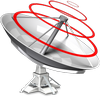A few weeks ago I got into a debate with a user on a local forum, who explains that the 5GHz WiFi band is generally nothing special – “higher speeds but smaller range”. On my suggestion that the smaller AP range and far more channels is what makes the 5GHz better over the 2.4GHz band, users counter response was – a problem with the radar signal on most 5GHz channels.
Radar signals problem is solved with the help of well-known DFS technique (Dynamic Frequency Selection). Since this technique is already well explained and tested, I will not discuss it here, but I will refer to a great WiFiNigel article – https://wifinigel.blogspot.com/2018/05/the-5ghz-problem-for-wi-fi-networks-dfs.html
Also, the following link shows how to practically test radar signal and DFS on your WiFi network – https://www.intuitibits.com/2017/11/17/practical-intro-dfs/
Since I live really close to an airplane take-off/landing path, I thought that the planes would cause a lot of radar hits on 5GHz WiFi, because of the weather radar implemented on them. However, according to the documentation of such radar systems, the frequencies at which these types of radars emit a signal are far higher (8-12GHz, usually around 9GHz).
However, I decided to check how often 5GHz was “attacked” by radar signals in my city (Belgrade / Serbia). For the purpose of DFS test I used Cisco 3502I AP (connected to Cisco WLC 2504 (8.5.140.0)), on which I turned off the 2.4GHz band. Under DCA option, I turned off non-DFS channels (36, 40, 44, 48) to make sure that the AP will always be on one of the DFS channels.
Cisco WLC displays radar “attacks” via SNMP, with the message that the operating channel has been changed and the reason for the change is “radar“. Messages on the WLC itself can be seen under the Management tab – SNMP – Trap Logs.
Cisco WLC does not have the capability to store a large number of these messages (only about 2000), and therefore requires an external SNMP server, which will collect and store everything that WLC sends. A small Linux computer (Intel Atom) serves as the SNMP server, with Ubuntu 14.04 as OS. To see only messages related to channel change due to the radar signal, I used the SA3ARK (Swedish radio amateur) Python script – https://sa3ark.wordpress.com/2018/07/30/detect-dfs-events-on-cisco-wlc/
I previously installed a couple of plugins on Ubuntu OS to make the Python script work. Note: Python 2.7 is initially installed with Ubuntu OS – DO NOT DELETE IT!!! Install a new Python version – 3.5 (the old one is not being deleted).
sudo apt-get update
sudo apt-get install python3.5
sudo apt-get install python3-lxml
sudo pip install –upgrade lxml
sudo apt-get install tshark
wget https://bootstrap.pypa.io/get-pip.py
sudo -H python3.5 get-pip.py
sudo -H pip install -U pip setuptools
sudo apt-get install git
git clone https://github.com/KimiNewt/pyshark.git
cd pyshark/src
sudo python3.5 setup.py install
sudo python3.5 dfs_script.py
Note: dfs_script.py is the name of the Python script for SNMP messages.
Test equipment (AP, WLC and laptop) is currently set up in my apartment and I will be monitoring the logs over the next few days. Over the next few weeks, I will radar test several different locations in the city and save logs, so that I can have clearer image about radar hits on 5GHz in my area.
Stay tuned…
